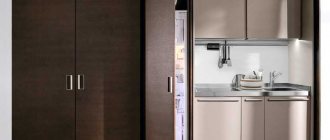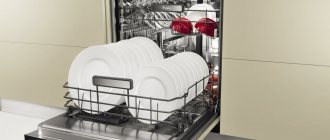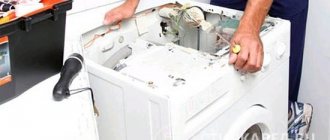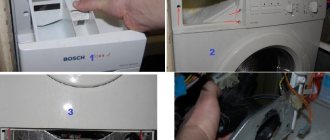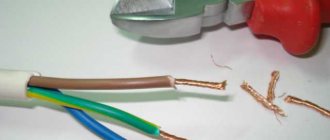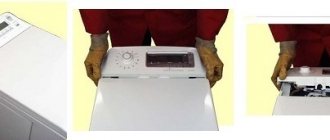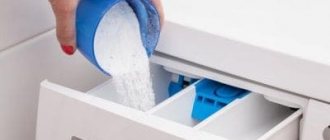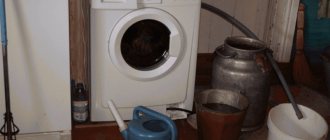Advantages and disadvantages of a washing machine in the kitchen
Let's look at the advantages of installing a washing machine in the kitchen.
- Freeing up space in a cramped bathroom.
- If the family is large and the bathroom is constantly occupied, after installing it in the kitchen, you can use the washing machine at any time.
Placing a washing machine in the kitchen has its disadvantages:
- A noisy machine prevents normal conversation during dinner or drowns out the sounds of the TV installed in the kitchen.
- The smell of household chemicals is not very appropriate where food is prepared and food is stored.
- Before washing, you still need to go to the bathroom to pick up dirty clothes. Everything you need is sorted and put into a basin; you will have to take the powder with you all the time if the detergent is not stored in the kitchen.
To get rid of the inconvenience, you can use several tips:
- Washing at night helps get rid of odors. You can load laundry when no one is in the kitchen.
- The powder is stored in tightly closed containers; it is better to place it in the next room.
- To prevent detergent from spilling, you can use liquid laundry mixtures.
- To reduce the noise level, you need to adjust the legs of the machine.
When arranging a kitchen from scratch, ceramic tiles are laid on the floor. It is not recommended to use parquet or laminate if there is a washing machine in the kitchen, since such flooring is susceptible to leaks.
Machine installation process
Almost all built-in models have special fastenings for both the cabinet and the countertop. Also, the built-in washing machine in the kitchen has special fastenings for the door hinges, which, in turn, require special hinges (sometimes the hinges are included).
Supply of communications to the washing machine
After the preparatory work, the washing machine is simply inserted into the cabinet that is not covered with a countertop. Then you should align the legs of the machine so that the fastenings to the tabletop are level. After this, the equipment is screwed to the cabinet. Then the communications are supplied (or connected).
Modern plastic water pipes have an advantage over cast iron or stainless steel ones: they can be easily and quickly brought to the desired location using a small number of tools.
After connecting the necessary communications, the doors (doors) of the cabinet are hung and aligned horizontally and vertically. The doors should be hung even when using a top-loading machine: they allow you to conveniently service the machine or quickly remove it for repair or replacement. After the door you can install a tabletop. Installing the tabletop last allows you to install the machine more comfortably. To secure it, pre-made wooden bushings are used, lubricated with glue, which are inserted into special grooves on the cabinet.
Washing machine under the countertop in the kitchen interior
Another option requires you to mount the countertop at the initial stage of installation. Although the latter option is the most common, it is much more labor-intensive than the option with late installation of the countertop. The installation of the countertop should exclude any pressure on the machine; the joint should be sealed with special silica gel to prevent water and food from entering the machine.
Built-in machines with vertical loading require special conditions, because in their case the tabletop-lid cannot be hermetically joined with its neighbors, so it is necessary to exclude the possibility of foreign liquids, objects or food debris getting on the machine.
Where is the best place to install a washing machine?
Washing. The machine in the kitchen is most often installed near the sink. This is the most convenient location; hoses of minimal length are used leading to the water supply and drainage. If the machine is installed far from the sink, some parts will wear out faster because more power will be needed to move water over long distances. You will have to choose hoses up to 5 or 7 m long.
Options for installing the machine in the interior:
- Installation under the countertop without a door;
- Location behind the facades and under the countertop;
- Built into a cabinet;
- Stationary location.
Hide the cabinet in the closet
Hidden installation requires the use of a cabinet under the washing machine. The technique is not suitable for every kitchen design. The machine may not fit into the niche if at least 1 cm is missing. With this option, the washing machine is not located on the floor, but is built in above the bottom shelf of the cabinet, and the owner does not have to bend and squat too much.
If you choose a machine for a ready-made kitchen, then the task is simplified, since manufacturers make many different built-in appliances that differ in size. It is often possible to choose a device based on dimensions that will fit perfectly into the prepared niche.
Standard dimensions of a cabinet for a washing machine:
- Width - from 45 to 70 cm.
- Height - from 50 to 130 cm.
- Depth - from 33 to 85 cm.
Doors are used when it is necessary to hide equipment due to its unattractive appearance. To do this, you will have to assemble an additional bedside table, or attach the facade to the side of a nearby kitchen unit element.
Main stages of work
After approval of the project and installation of the kitchen unit, the installation of the device is carried out directly. Fully built-in appliances, as a rule, during the installation process provide for the presence of a furniture plinth at the bottom of the machine. For this purpose, there is a special recess on the body. The height is adjusted with special legs. The front door is attached to the machine body with special hinges. Connecting to communications is carried out in the same way as connecting classic devices.
The integration of a free-standing machine into a set begins with removing the top cover. Sometimes the top of the case is covered with a special plate, which is included in the kit. Next, all overall dimensions of the niche are checked and made sure that they correspond exactly to the dimensions of the built-in machine.
Washing machine hose connection diagram.
After this, the water supply and sewer drain are connected. When calculating water communications, it is advisable to take into account the length of the supply hoses, that is, there must be a certain reserve that will allow, if necessary, to pull the washing machine out of the unit without disconnecting the pipelines.
The pressure hose is connected to the water main using a tee, which is installed in a convenient place where there are threaded connections, for example, at the point where the mixer hose joins the cold water pipeline. A shut-off valve is installed between the outlet of the tee and the pressure hose of the machine. It is possible to install a tee directly into the main by welding it into a plastic water supply or using a fitting connection.
The drain hose can be connected in two ways. In the first case, a special drain siphon is required in the kitchen sink, which has an outlet for connecting a hose. In the second case, a tee is inserted into the sewer bed running in the kitchen, and a drain pipeline is connected to it. It is important to remember here that before entering the sewer, the drain hose must have an elbow-shaped bend 45-50 cm high.
Layout of sockets when connecting a washing machine.
The electrical part includes the presence of a power outlet or residual current device in the apartment circuit. If this is not available, then it is possible to install a special socket in which an RCD is built in. It is important to remember about grounding; if it is not provided for in the house design, then the presence of an RCD is mandatory, and grounding of an earthen allotment is strictly prohibited.
Built-in behind the facade under the countertop
To install the machine behind the façade under the countertop, you need to choose a floor-mounted kitchen cabinet that matches the width, height and depth. Typically, this height is from 80 to 85 cm. Full-size washing machines reach a height of 85 cm. It is recommended to give preference to appliances with a height of up to 70 cm. Machines with a removable lid are available for sale. The top is removable and the size is adjustable.
Standard sizes: 60 cm and 80 cm. Therefore, the dimensions of the machine will be several centimeters smaller. A gap between the appliances and the side of the furniture must be left to accommodate the door hinges.
The height of the washing machine should not exceed the size of the bedside tables
The depth of washing machines reaches 60 cm. When choosing a product that needs to be hidden behind the door, the depth of the cabinet is taken into account. Therefore, in the kitchen you can install appliances up to 50-55 cm deep.
Sometimes this detail is not necessary; the lower part is covered with a base. Otherwise, the kitchen cabinets will have to be strengthened.
Since the equipment will vibrate, all parts of the housing must be firmly connected
Often household appliances turn out to be several cm larger than furniture and do not fit under the countertop. The dimensions of the washing machine are always taken into account when producing custom-made kitchen units. Therefore, it is recommended to buy equipment before installing a washing machine. The tabletop rises slightly if necessary. If it is difficult to change the furniture configuration, you will have to choose a device whose dimensions can be adjusted.
How to integrate a washing machine into the kitchen: stages of work
A washing machine is an integral attribute of a modern home.
At the same time, the layout of many apartments does not always allow for an aesthetically pleasing and practical installation of a washing machine. Sometimes people who live in small apartments have to choose compact device options or install the machine in a cramped bathroom or in an empty space in the kitchen. This approach is irrational, since it additionally takes up the working space of the kitchen or bathroom. From an aesthetic point of view, a free-standing unit with open communications does not bring anything pleasant to the design of the room. Scheme of installing a washing machine in the kitchen.
The best and at the same time rational solution to the problem of choosing a place to install a washing machine is to integrate it into a kitchen unit. How to integrate a washing machine into the kitchen and still get the desired result? To do this, you need to understand certain subtleties of such work.
Content:
- Types of embedding machines
- Methods for integrating washing machines into kitchen units
- Main stages of work
- Atypical cases of equipment installation
- List of required tools
Under countertop without door
In cases where the washing machine is in harmony in color, or the same color as the oven, vacuum cleaner and refrigerator, then the use of a door is not necessary
The choice of equipment always depends on the external preferences of the owners, the layout and dimensions of the cabinet
Another way to install a machine under a countertop without a door is to paste it with a special film in a color that matches the interior.
Open inpatient placement
For permanent installation, you can use equipment with vertical loading of laundry. The equipment can be installed in any convenient niche; it can be opened from the top and bottom.
When placing the machine permanently? it does not close with the countertop
Top-loading washing machine built into the unit near the sink
